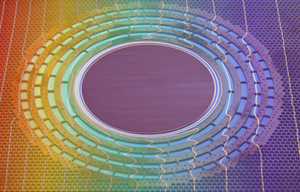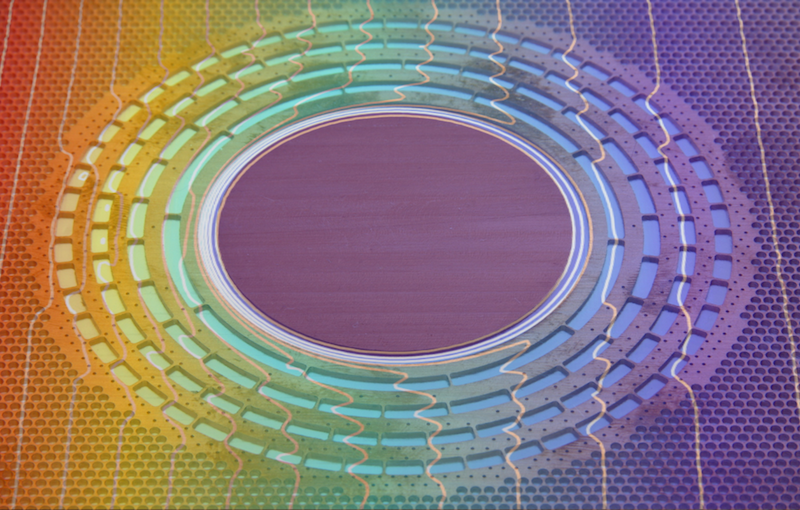Invisibility Cloak for Heat
Researchers have devised ways to force light rays to detour around an object in a way that is reminiscent of the invisibility cloaks of science fiction. Now a team reporting in Physical Review Letters demonstrates that they can similarly manipulate the flow of heat on a sheet of metal to hide a large obstruction in the sheet. Although heat cloaking as such does not have a clear practical use, the same principles could potentially be used, for example, to guide the flow of heat or electricity, or the diffusion of chemicals.
The propagation of light can be approximated as rays that produce an accurate image of an object. But if they pass through material whose optical properties vary in space, like the hot air above a desert highway, the rays will bend, so the image is a deceptive mirage. The developing discipline of transformation optics tells researchers how to modify the material around an object to alter or even eliminate its image.
Heat, unlike light, is governed by diffusion, so it gradually spreads out in all directions and washes out any fine details. But it can still be used to image a hidden feature, such as a defect buried in a material, which can show up as a cold spot on the top surface as heat flows upward from below. The signature is particularly pronounced following a sudden temperature change.
Last year, researchers from Harvard University modified a thin metal sheet so that heat flowing along the sheet would be diverted around an object or through it, or even flow around behind it and come back toward the heat source [1]. However, the object was not completely “cloaked” because the team did not make the heat signal look as it would in the absence of the object, and they only studied heat flow that did not change with time. At about the same time, Sebastien Guenneau of Marseille University, France, and his colleagues presented a theoretical recipe for rendering a two-dimensional object completely invisible to even time-varying temperature changes [2]. Now a group led by Martin Wegener of the Karlsruhe Institute of Technology, Germany, has worked with Guenneau to experimentally demonstrate this cloaking of time-dependent heat flow.
The researchers manipulated heat flow by cutting grooves and holes in a copper sheet and filling them with a rubbery thermal insulator. Their structure consisted of a -centimeter-diameter copper disk—the cloaked object—surrounded by concentric copper rings. Each ring was connected to its neighbors by a few thin spokes of copper. This structure allows heat to flow easily around the rings but much more slowly in the radial direction. Over large distances, the patterned sheet acts as a “metamaterial,” with average properties that are different from pure copper and that vary in a prescribed way with position.
The team simultaneously submerged one side of their structure in hot water and the other side in room-temperature water. They used an infrared camera to make a temperature “movie” of the heat flowing across the structure and confirmed their theoretical prediction: the time-varying temperature distribution away from the disk was precisely what would be expected for an unaltered copper sheet. The team also showed that the complex ring structure was important, since simply insulating the disk from the rest of the sheet resulted in a quite different temperature profile.
There is no obvious application for the cloaking of heat flow, admits Robert Schittny of the Karlsruhe team. “We chose it because it’s the benchmark experiment” to demonstrate this kind of manipulation, although the principles could now help control heat in other settings. But the principles might be useful for other diffusing entities like electric current or chemical concentrations. “It’s a fun thing,” says John Pendry of Imperial College, London, but “the research is at the stage where people are saying ‘Hey, here’s a new toy, let’s just see what we can do with it. After that we’ll figure out what we can make with it that we can sell to someone.’”
–Don Monroe
Don Monroe is a freelance science writer in Murray Hill, New Jersey.
References
- S. Narayana and Y. Sato, “Heat Flux Manipulation with Engineered Thermal Materials,” Phys. Rev. Lett. 108, 214303 (2012)
- S. Guenneau, C. Amra, and D. Veynante, “Transformation Thermodynamics: Cloaking and Concentrating Heat Flux,” Opt. Express 20, 8207 (2012)





